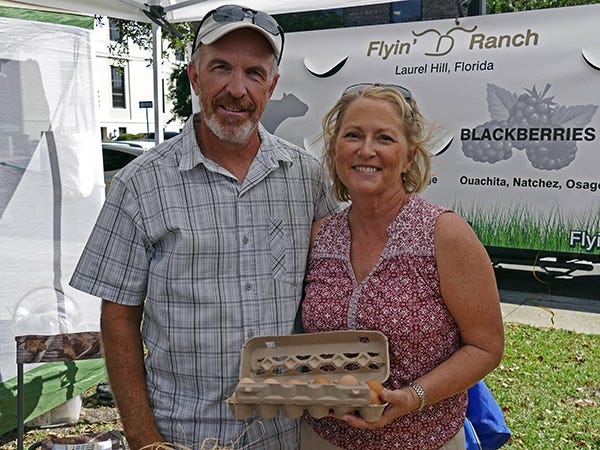
LAUREL HILL — Randy and Tracey Duncan stay busy for a retired couple.
A typical day starts with feeding and watering the pigs and chickens, bottle-feeding a calf separated from her mother, checking the cows and collecting eggs. Those need to be gathered from more than 60 chickens three or four times a day.
Approximately 1,000 blackberry plants are worked daily in season and weekly the rest of the year. A row of 600 muscadine grape vines produced hundreds of pounds of grapes that Tracey used to make jelly for friends and family.
The Duncans drive their eggs, meats and berries to Gulf Breeze Farmers Market on Tuesdays and Palafox Farmers Market on Saturdays to sell.
“This is what we do for fun,” Tracey said.
Their farming and ranching careers on Flyin D Ranch began in 2012 when they moved onto 300 acres 16 miles northeast of Crestview.
“I retired from an office job to a real job,” said Randy, a former chief financial officer for an aerospace corporation. Tracey is a retired schoolteacher. Although they aren’t from farming families, the Duncans owned a few cows when they lived in Texas, and Tracey has always kept a garden. “We want to know what we eat,” she said.
The land they wanted to transform into a diverse operation consisted of row-cropped cotton fields and unmanaged woods. They started by contacting USDA’s Natural Resources Conservation Service.
District Conservationist Darryl Williams helped them develop a conservation plan and get technical and financial assistance to plant grass, build cross fencing, install drip irrigation and install a solar panel to power a water pump that supplies water to cattle on two pastures.
Since they started their operation in the last 10 years, they qualified for funding through the New and Beginning Farmers and Ranchers category of the Environmental Quality Incentives Program.
The Duncans entered into a Conservation Stewardship Program contract in 2014 on 200 acres of pastureland. Some of the management practices the program helped fund include grazing management to improve wildlife habitat, monitoring key grazing areas, restoring rare and declining habitats and maintaining a riparian buffer.
“Darryl has made every process with NRCS very manageable,” Tracey said.
The Duncans rotate 78-head of grass-fed, antibiotic and hormone free Brangus cattle on six pastures also used to grow hay for feed and to sell.
“Pasture management is important, so we built all the fences far away from the creek,” Randy said. Horsehead Creek runs through their property and drains into the Yellow River in route to the Blackwater River and eventually to the Gulf of Mexico.
Their heritage Tamworth hogs are a breed originating in England that Randy chose because it has fatter marbling than in today’s breeds. They have seven sows and two litters of pigs.
“We like our pork,” he said.
Pest management on the farm is natural. The Duncans release chickens to roam near their blackberries and vegetables, installed 20 hummingbird feeders and built 11 bluebird houses.
The chickens and pigs feed on non-GMO feed. Tracey said customers like that. The chickens are a recent addition to their operation.
“Our granddaughter told Randy we didn’t have a real farm because it didn’t have chickens, so he took care of that,” Tracey said.
“So many kids don’t know where their food comes from,” she said.
Next year the Duncans are building a high tunnel to raise vegetables year-round and planting food plots for wildlife. They are also considering removing 100 acres of scrub and reestablishing longleaf pine.
“Anything to do with wildlife is important. We have some quail and a healthy turkey population,” Tracey said.
NRCS is accepting applications for CSP until Feb. 3. If interested, visit your local NRCS field office and request help developing a conservation plan.


This article originally appeared on Crestview News Bulletin: Retirees enjoy ranching, agriculture in Laurel Hill
